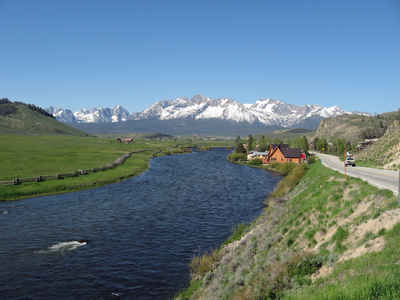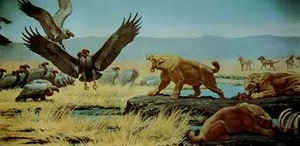Idaho State Fossil
Hagerman Horse Fossil

(Equus simplicidens) originally described as (Plesippus shoshonensis)
Adopted on March 16, 1988.
The 1988 Idaho legislature designated the Hagerman Horse Fossil, (Equus simplicidens,) as the official state fossil. 3.5 million year old sediments at the Hagerman Fossil Beds National Monument in Idaho contain the world's richest known fossil deposits from the late Pliocene epoch (200 horse skeletons have been recovered at the Hagerman Fossil Beds, 20 of which are complete).
he Hagerman horse (Plesippus shoshonensis, formerly called Equus simplicidens) is the oldest known representative of the modern horse genus Equus (includes horses, donkeys, and zebras) and is believed to be more closely related to the living Grevy's zebra in Africa than our modern horse.
Idaho State Fossil: Hagerman Horse Fossil

Did you know horses evolved in North America? The Hagerman Horse, (Equus Simplicidens,) was the first true horse but its' bones most closely resembled Grevy's zebra bones.
Horses evolved in Asia and they entered North America across the Bering Land Bridge, a connection between Alaska and Siberia during a time of lowered sea level. They went extinct in North America around 10,000 years ago.
The Hagerman Horse lived in Idaho during the Pliocene Epoch, around 3.5 million years ago. It shared a grassy plains/riverine habitat with mastodons, sabertooth cats, beavers, otters, and waterfowl. The average Hagerman Horse was about the same size as a modern zebra or Arabian horse, and likely possessed a stiff mane and fur arrangement similar to that of these modern equines.
The Hagerman horse is the oldest known representative of the modern horse genus Equus (includes horses, donkeys, and zebras) and is believed to be more closely related to the living Grevy's zebra in Africa. The 3.5 million year old sediments at the Hagerman Fossil Beds National Monument contain the world's richest known fossil deposits from the late Pliocene epoch.
This rich fossil bed has yielded over 130 complete horse skeletons, was discovered in the 1920s near Hagerman and is said to be the best known Pleistocene-epoch fossil site in the world. Discovered in 1928, it was originally described as Plesippus shoshonensis. Subsequent research found the Hagerman horse to be the same as a previously described species and it is now known as Equus simplicidens.
In 1929, paleontologists from the Smithsonian Institution in Washington, D.C., made the first scientific excavations at Hagerman Fossil Beds. A local rancher, Elmer Cook, had shown the fossil beds to a government geologist, Dr. Harold Stearns. The Smithsonian finds led to more expeditions in the 1930s. Its National Museum of Natural History excavated 120 horse skulls and 20 complete skeletons from an area called the Horse Quarry. The Hagerman Horse, (Equus simplicidens,) exemplifies the quality of fossils. From these fossil beds have come both complete and partial skeletons of this zebra-like ancestor of today's horse. The Smithsonian exchanged some of these Hagerman Horse skeletons with other museums, which has resulted in their display around the world. Additional scientific expeditions have been conducted over the years by other museums and universities.
The more than 200 vertebrate, invertebrate, and plant species preserved there represent the last vestiges of animals that existed prior to the Ice Age and the earliest appearances of modern flora and fauna.
Timeline of the Hagerman horse
Holocene (present)
- Horses reintroduced into North America by Spanish 1500s
- Extinction of North American megafauna, including horses 11,000-10,000 BP
- Bonneville Flood 15,000 BP
- Damming of Snake River by McKinney Butte Basalt 50,000 BP
- Immigration of bison into North America from Eurasia 400,000 BP
- Lake Idaho drains 1.7 mya
- Immigration of mammoth into North America from Eurasia 1.9 mya
Pleistocene 2 mya
- First appearance of modern horse Equus at Hagerman 3.2 mya
- Volcanic eruption at Yellowstone deposits Peters Gulch Ash at Hagerman 3.7 mya
- Ancestral Snake River begins depositing sediments at Hagerman 4 mya
- First appearance of modern beaver, Castor 4.8 mya
- Extinction of rhinos in North America 4.8 mya
Pliocene 5 mya
- Banbury Basalt forms floor of what is now the Hagerman Valley 8-11 mya
- Bruneau-Jarbridge eruption south of Hagerman deposits ash as far east as Nebraska 11 mya
- First elephants (gomphotheres) immigrate into North America from Eurasia 14.5 mya
Miocene 25 mya
- Gap in the record (unconformity)
- First appearance of beavers 35 mya
Oligocene 38 mya
- Volcanism in the Challis area begins 51 mya
Eocene 55 mya
- First horse, Hyracotherium 57.5 mya
Paleocene 65 mya
- Extinction of dinosaurs 65 mya
- Gap in the record (unconformity)
Idaho Session Law
STATE FOSSIL
Idaho Session Laws, 1988, page 50.
AN ACT, RELATING TO THE STATE FOSSIL; AMENDING CHAPTER 45, TITLE 67, IDAHO CODE, BY THE ADDITION OF A NEW SECTION 67 4507, IDAHO CODE, TO PROVIDE THAT
THE HAGERMAN HORSE FOSSIL SHALL BE THE STATE FOSSIL OF THE STATE OF IDAHO.
Be It Enacted by the Legislature of the State of Idaho:
Section 1. That Chapter 45, Title 67, Idaho Code, be, and the same is hereby amended by the addition thereto of a NEW SECTION, to be known and designated
as Section 67 4507, Idaho Code, and to read as follows:
67 4507. STATE FOSSIL DESIGNATED. The Hagerman Horse Fossil (species Equus simplicidens originally described as Plesippus shoshonensis) is hereby designated
and declared to be the state fossil of the state of Idaho.
Approved March 16, 1988.
Idaho Statutes
The law designating the Hagerman Horse Fossil as the official Idaho state fossil is found in the Idaho Statutes, Title 67, Chapter 45, Section 67-4507
TITLE 67
STATE GOVERNMENT AND STATE AFFAIRS
CHAPTER 45
67-4507. STATE FOSSIL DESIGNATED. The Hagerman Horse Fossil (species Equus simplicidens originally described as Plesippus shoshonensis) is hereby designated
and declared to be the state fossil of the state of Idaho.
Taxonomic Hierarchy: Hagerman Horse Fossil
Kingdom: Animalia - animals
Phylum: Chordata - chordates
Subphylum: Vertebrata - vertebrates
Class: Mammalia
Order: Perissodactyla
Family: Equidae
Genus: Equus
Species: Equus simplicidens

Some states that lack a "state fossil" have nevertheless singled out a fossil for formal designation such as a state dinosaur, rock, gem or stone.







